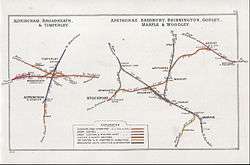Glazebrook East Junction–Skelton Junction line
Glazebrook East Junction–Skelton Junction line was a railway line from Glazebrook to Skelton Junction in Greater Manchester.[1]


History
Glazebrook East Junction–Skelton Junction line was part of Cheshire Lines Committee (CLC) as a branch line of their main Liverpool–Manchester lines. The line carried on through Skelton Junction terminating at Stockport Tiviot Dale
It opened in 1873 serving the towns of Cadishead, Partington and West Timperley before joining the Manchester, South Junction and Altrincham Railway (MSJ&AR) at Skelton Junction which was also part of the CLC at this time.
In the 1890s the line was deviated due to the building of the Manchester Ship Canal. It was raised on an embankment around a mile in length from Glazebrook East Junction to be high enough to clear the Ship Canal and Cadishead Viaduct was built in 1892 to span the canal.
The line saw little change in the late 19th and early 20th centuries and it remained part of the CLC in the 1923 Grouping. On nationalisation it became part of the London Midland Region of British Railways in 1948 at the final demise of the CLC.
Closure
Passenger services
As part of the London Midland region of BR, It remained a busy line with trains from Liverpool Central and Warrington Central up until the mid-1960s. It was only on the withdrawal of these stopping passenger services in 1964 that all the stations closed along the line.[2]
Freight services
The line carried on as freight only until 1983 when Cadishead Viaduct was in need of serious and costly repair.[3] British Rail decided rather than repairing the viaduct to close it and mothball the line. The tracks were lifted in the mid-1980s from Glazebrook to Partington.
Privatisation
As the line was closed prior to the privatisation of British Rail, only Glazebrook East Junction and the line from south of Partington to Skelton Junction were passed over into Railtrack ownership which in turn passed to Network Rail.[4]
The trackbed from Cadishead to Partington remained (and remains to this day) in the ownership of Highways Agency Historical Railways Estate.[5]
Today
Glazebrook East Junction
As of 2010 Glazebrook East Junction is still intact and remains part of the national network. The junction towards Cadishead on the original deviation is also still in place with a powered signal lamp showing a permanent red signal. This short section of track from the still live passing loop at Glazebrook East Junction towards Cadishead on the original non-deviated line is permanently point locked. The short section ends near a barrow crossing shortly before a bridge carrying a bridleway above.
Skelton Junction
The tracks from Skelton Junction to the south east of Partington were left and remained intact for chemical trains for a local chemical plant. These trains continued to use this route until 10 October 1993. To this day however this part of the line is intact but disused; the signal lamps at Skelton Junction remain powered red. Also in 2005 this part of the track saw some work; vegetation clearance took place for the line to reopen for freight but this fell through.
Reopening plans
In 2010 the Liberal Democrats announced plans to reopen thousands of miles of disused and abandoned tracks and it is hoped this line will reopen sometime in the future. This appears an easy process as all the infrastructure of the line is still in place, bar the tracks signalling etc. However, it would cost millions of pounds to bring Cadishead Viaduct up to a safe and usable standard along with all the other decaying bridges along the line which have seen little or no maintenance in 26 years since the line was closed.
In 2017, businessman Neil McArthur launched a campaign to reopen the line as a heritage railway,[6] with an adjoining footpath and cycle track.[7]
In January 2019, Campaign for Better Transport released a report identifying the line which was listed as Priority 2 for reopening. Priority 2 is for those lines which require further development or a change in circumstances (such as housing developments).[8]
References
- "Glazebrook East Junction Sidings". disused-stations.org.uk. Retrieved 2013-04-10.
- The Reshaping of British Railways by Dr Richard Beeching 1963
- BRB(Residuary) Report from 1982
- BRB(Residuary)
- BRB (Residuary) Website Property Listings
- Neal Keeling (2017-03-28). "Businessman's ambitious £30m plan to get steam trains crossing the Manchester Ship Canal again". Manchester Evening News. Retrieved 2017-04-04.
- David Prior (2017-03-29). "Steam trains back at Timperley station? £30m plan unveiled to revive disused rail line". Altrincham Today. Retrieved 2017-04-04.
- p.42